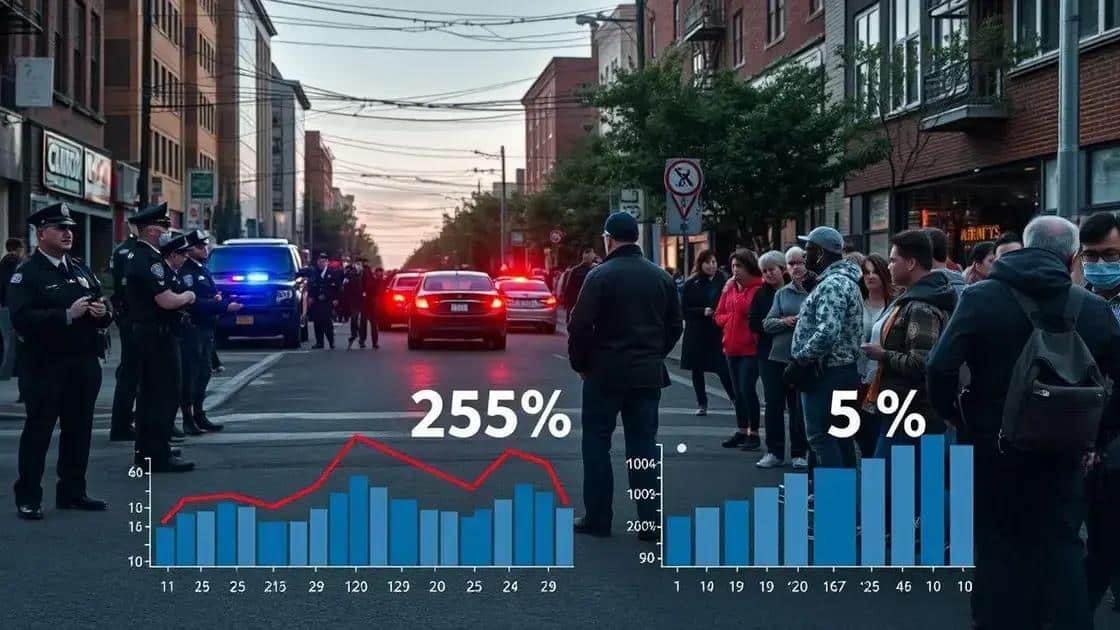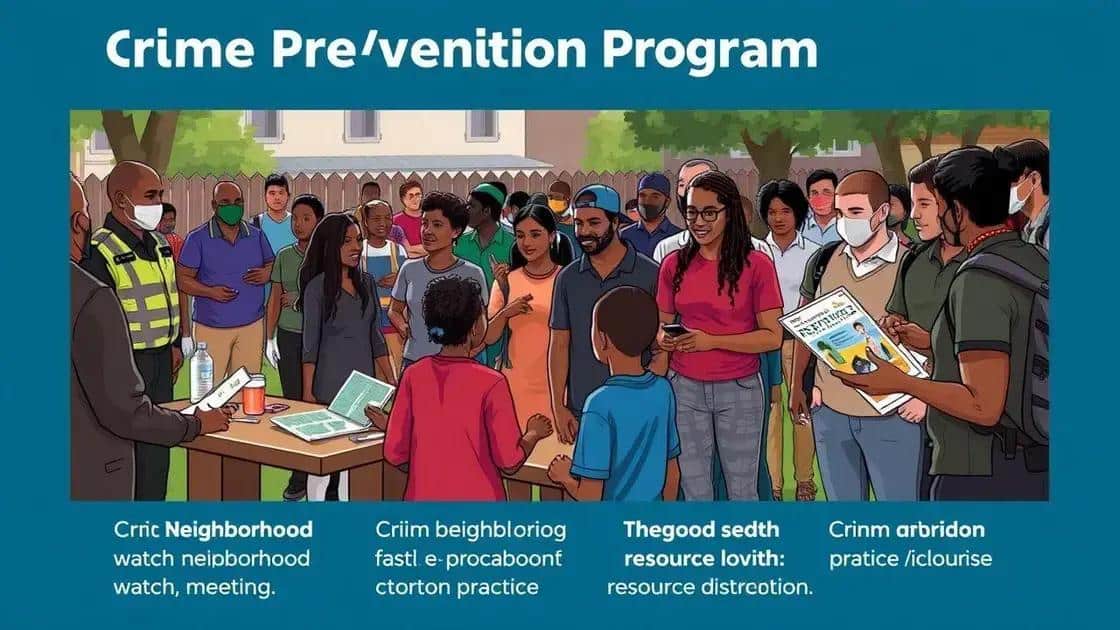Note crime trends usa: what you need to know

Note crime trends in the USA highlight the influence of economic conditions, technology advancements, and community engagement on crime rates, with a growing emphasis on proactive prevention strategies.
Note crime trends usa can be crucial in understanding the safety of our communities. Have you ever wondered how these trends affect your neighborhood? Let’s explore the current landscape.
Understanding current crime statistics in the usa
Understanding current crime statistics in the usa is essential for grasping safety trends in different areas. These statistics find their roots in various factors, painting a vivid picture of how crime impacts communities.
Current Crime Rates Overview
The latest reports indicate that crime rates fluctuate across regions. This variation is often influenced by several key elements. Here are some notable statistics:
- Urban areas typically report higher crime rates than rural regions.
- The type of crime can vary significantly, with property crime prevalent in some places and violent crime in others.
- Recent years have shown a slight increase in certain offenses, prompting community action.
Crime data not only informs citizens but also shapes policies. Local governments utilize these statistics to allocate resources effectively. By understanding the patterns, authorities can develop targeted strategies to combat crime.
Factors Influencing Crime Rates
Several factors play a role in influencing crime rates across the usa. Economic conditions, social dynamics, and even geographic features significantly impact how we perceive safety.
- Higher unemployment can correlate with increased crime.
- Community programs often help mitigate crime through engagement.
- Socioeconomic disparities lead to uneven crime distribution.
By analyzing these influences, we can develop a deeper understanding of how crime affects society. It is crucial to continue studying these aspects to predict future trends.
Factors influencing crime rates across different regions
Many factors influence the rise and fall of crime rates across different regions. Understanding these factors helps communities assess safety and security more effectively.
Economic Conditions
The economy plays a critical role in determining crime rates. In areas facing economic hardships, such as high unemployment, crime tends to increase. Individuals may feel desperate and resort to crime as a means of survival. This cycle can perpetuate as communities become less stable.
- Regions with low income levels often report higher crime.
- Economic downturns correlate with spikes in certain crimes.
- Job creation can lead to lower crime rates.
By improving job opportunities, communities can effectively work towards reducing crime.
Social Dynamics
The social environment also significantly influences crime rates. Communities with strong social ties often experience lower crime because residents look out for one another. On the other hand, areas with weak community connections see higher crime rates.
- Neighborhood watch programs can strengthen community bonds.
- Youth engagement initiatives help divert at-risk youth from crime.
- Access to education and resources plays a crucial role.
When residents collaborate and foster connections, it becomes harder for crime to thrive.
Geographic Features
The geographic layout of an area can either enhance or inhibit crime. Areas with many public spaces may face higher crime rates due to increased foot traffic. Conversely, secluded neighborhoods may deter criminal activity. Accessibility to public transportation also impacts crime patterns.
- Urban areas tend to show higher crime due to density.
- Rural locations often report low crime rates.
- Natural barriers can help reduce crime opportunities.
Overall, the interplay between these factors shapes the unique crime landscape in different regions.
The role of community programs in crime prevention

Community programs play a vital role in crime prevention by fostering connections and trust among residents. These initiatives aim to create safer environments and reduce crime through proactive engagement.
Building Strong Relationships
One key function of community programs is to build strong relationships among residents. When people know their neighbors, they are more likely to watch out for one another. This sense of connection prevents crime as it makes neighborhoods less appealing to potential offenders.
- Neighborhood watch initiatives encourage vigilance.
- Community events foster bonding and trust.
- Strong social ties can deter criminal activity.
By promoting community involvement, these programs empower individuals to take an active role in maintaining safety.
Providing Resources and Support
Community programs often provide essential resources to at-risk individuals. Access to education, job training, and mental health services can help reduce crime rates significantly. When people feel supported, they are less likely to turn to criminal behavior.
- Job training programs enhance employability.
- Educational initiatives keep youth engaged.
- Mental health services address underlying issues.
Offering these resources builds resilience in the community and encourages positive choices.
Engaging Youth in Positive Activities
Youth engagement is another critical aspect of crime prevention. Programs targeting younger generations provide constructive outlets for their energy and creativity. When youth have opportunities to participate in sports or arts, they are less likely to engage in crime.
- After-school programs offer supervision and mentorship.
- Sports leagues build teamwork and discipline.
- Art programs promote expression and inclusivity.
Such engagement not only keeps kids off the streets but also builds a sense of belonging within the community. This approach nurtures future generations to make positive choices.
Technology’s impact on crime detection and reporting
Technology has transformed the way crime detection and reporting are conducted in today’s society. With the advent of advanced tools and systems, law enforcement can respond to incidents more efficiently and effectively.
Advanced Surveillance Techniques
Modern surveillance technology includes high-definition cameras and real-time monitoring systems. These tools enhance the ability to detect crimes as they happen. Law enforcement agencies can keep a close eye on neighborhoods and gather vital evidence.
- Smart cameras can recognize faces and license plates.
- Live feeds allow for immediate response to suspicious activities.
- Data analytics help identify crime trends and hotspots.
By employing these technologies, police can prevent crime and strengthen community safety.
Crime Reporting Apps
Another significant development is the rise of crime reporting apps. These applications allow residents to report incidents quickly and anonymously. Such tools empower communities by facilitating communication with local authorities.
- Users can submit reports with photos and videos.
- Real-time alerts keep communities informed of local threats.
- Feedback mechanisms help improve local policing.
As communities engage with these platforms, they create a more proactive approach to safety.
Data Sharing and Collaboration
Technology also enables improved collaboration between different law enforcement agencies. By sharing information and resources, agencies can tackle crime more effectively. Collaborative efforts to streamline data enhance the overall crime-fighting process.
- Inter-agency communication improves response times.
- Shared databases help track repeat offenders.
- Coordinated efforts reduce overlapping jurisdictions.
Overall, the integration of technology in crime detection not only enhances public safety but also fosters trust between communities and law enforcement.
Future predictions: where crime trends are headed
Future predictions regarding crime trends are essential for understanding how society may evolve. By analyzing data and patterns, experts can identify potential shifts in criminal behavior and community safety.
Emerging Crime Patterns
One significant prediction is the rise of cybercrime. As technology continues to advance, more people are vulnerable to online threats. Criminals are expected to exploit this growth, targeting sensitive data and financial assets.
- Identity theft is likely to increase as online interactions rise.
- Ransomware attacks on businesses and individuals may become more common.
- Fraud schemes will evolve with advancements in technology.
Awareness and education about these threats will be crucial in combating cybercrime.
Impact of Economic Factors
The economy plays a vital role in crime trends. Should economic conditions worsen, we might see a spike in property crimes, such as burglary and theft. Individuals facing financial strain may resort to illegal activities as a means of survival.
- Increased unemployment can lead to higher crime rates.
- Poverty and lack of opportunities often correlate with crime.
- Economic recovery may help lower crime statistics.
Society’s ability to provide support during challenging times could help mitigate this potential increase.
Community Engagement and Crime Prevention
Another prediction is the growing importance of community engagement in crime prevention. The rise of social media and community programs can empower residents to contribute to local safety.
- Neighborhood watches may become more organized and effective.
- Community policing strategies will foster trust between residents and law enforcement.
- Technology can facilitate better communication and reporting of suspicious activities.
By working together, communities can build a safer environment, potentially lowering crime rates.
FAQ – Frequently Asked Questions about Crime Trends and Prevention
What are the main factors influencing crime trends in the USA?
The main factors include economic conditions, community engagement, and advancements in technology. These elements significantly impact crime rates.
How is technology changing crime detection and reporting?
Technology is improving crime detection through advanced surveillance systems and crime reporting apps. These innovations allow for quicker responses and better data collection.
What role do community programs play in crime prevention?
Community programs foster relationships among residents, provide resources, and engage youth in positive activities, all of which contribute to reducing crime.
What are the predictions for future crime trends?
Future trends may include an increase in cybercrime as technology evolves, along with greater community involvement in crime prevention efforts.






